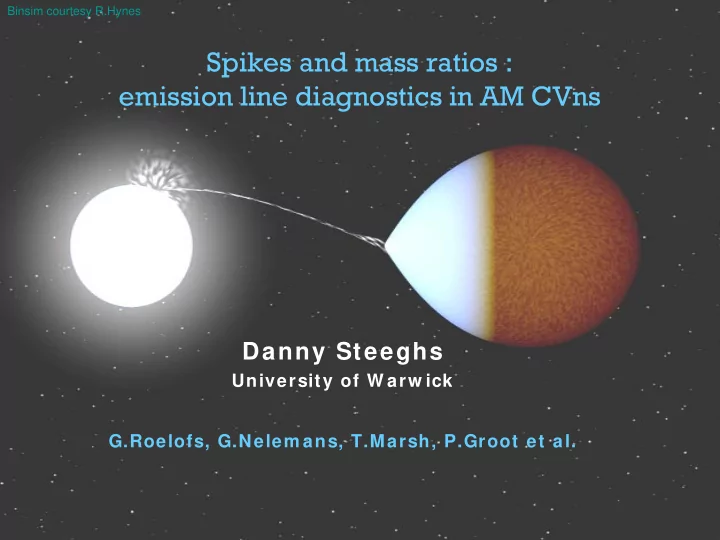

Binsim courtesy R.Hynes Spikes and mass ratios : emission line diagnostics in AM CVns Danny Steeghs University of W arw ick G.Roelofs, G.Nelem ans, T.Marsh, P.Groot et al. Danny Steeghs
Emission line spectra • facilitate their discovery/ identification (see P .Groot) • sample the abundances of the donor star • provide a detailed dynamical probe of the emission line regions Danny Steeghs
Danny Steeghs Emission lines from a disk
Key locations � Donor star with velocity K2 � Accretor with velocity K1 � (Ballistic) accretion stream � Accretion disk � Stream-disk interaction � Stream-accretor interaction (direct impact) Danny Steeghs
Spectroscopic periods • Complex photometric behaviour of AM CVn stars makes a solid identification of the binary period difficult • The stream-disk impact localisation provides a common beacon in the binary frame • Kicked off by fast spectroscopy of AM CVn itself Accretion disc + bright spot emission (Nelemans, Steeghs & Groot 2001) Danny Steeghs
Period distribution of current AM CVn systems Danny Steeghs
Danny Steeghs The (almost) twins GP Com & V396 Hya OII 4659 V3 9 6 Hya CII 4267 GP Com
The (almost) twins GP Com & V396 Hya GP Com N blends V3 9 6 Hya Danny Steeghs
Danny Steeghs GP Com & V396 Hya
orbital phase 0 1 2 Central spike from the accreting WD K 1 = 11.7 km/ s Danny Steeghs
Emission spikes from the white dwarf • Spikes all move in phase and with the same amplitude = > near WD (Marsh 1999) • However, spike mean velocity changes significantly from line to line (~ 0-50 km/ s ) • Some lines show double spikes, each moving together • Both GP Com and V396 Hya show the same pattern, other AM CVn systems show spikes as well (Roelofs et al.) • Spikes are narrow, though non- Gaussian appears not to be consistent w ith • Stark effect in high-density line DB/ EHe m odels for Stark-shift and split ( Beaucham p et al. 1 9 9 7 ) formation region? (Morales-Rueda et al. 2003) Danny Steeghs
Beauchamp et al. (1997) Stark profiles n e =10 15 cm -3 10 16 cm -3 -100 km/s +100 km/s velocity -100 km/s +100 km/s velocity Both velocity of peak and overall profile shape depends on n e Danny Steeghs
Danny Steeghs Observed split spike profiles
Spike velocity shifts Decent match to the family of spike profiles (both shift and shape) for n e = 3 10 15 cm -3 Danny Steeghs
Spikes at the accreting WD • Single density Stark profiles describe the spike properties in both GP Com and V396 Hya • Kinematics and density conditions of the spike match an emission line region tied to the accreting white dwarf • Provide us with the orbital velocity K1, the absolute binary phase and the (Stark corrected) systemic velocity • Unknown binary space velocity prevents us from converting the overall velocity offset (+ 16-17 km/ s) into a gravitational red-shift Danny Steeghs
Rotation • Spikes are relatively narrow, and shapes are dominated by the Stark broadening profile • Need very little rotational broadening ! • From HeII 4686 : vsini = 60 – 85 km/ s • White dwarfs appear to be rotating slowly, unless the spike photosphere does not co-rotate with the white dwarf Danny Steeghs
Doppler maps GP Com HeI 3888 V396 HeI 5015 Danny Steeghs
Mass ratio from disk-stream impact : ballistic GP Com V396 Hya q q Danny Steeghs
Mass ratio from disk-stream impact : disk velocities ballistic mix disk velocities Danny Steeghs
Mass ratios from spike + impact spot • GP Com q = 0.019 ± 0.002 • V396 Hya q = 0.013 ± 0.002 • SDSS J1240 (Roelofs et al. 2005) q = 0.039 ± 0.010 • AM CVn (Roelofs et al. 2006) q = 0.18 ± 0.01 • (SDSS J1552) Danny Steeghs
Double hot-spots ; stream overflow ? SDSS J1240 + sn2003aw V396 Hya not sensitive to q ? Roelofs et al. 2005 Danny Steeghs
Danny Steeghs The (almost) twins GP Com & V396 Hya V3 9 6 Hya GP Com
Danny Steeghs V3 9 6 Hya GP Com Non-moving absorption lines ; circum-binary ?
Danny Steeghs ES Ceti with Magellan
ES Cet at 10.3 mins HeII 4686 HeII 5411 No measurable polarisation (< 0.1% ) argues against a magnetically channeled flow Danny Steeghs
The accretion geometry constant variable A disk is present, though containing a strong asymmetry, most likely the stream-disk interaction No classic direct-impact, but how far does the stream penetrate? Strong orbital modulations in the UV (HST/ XMM) Danny Steeghs
Conclusions and outlook • Jan-Erik’s Question : What do AM CVns look like? emission lines can tell us what the accretion flow looks like • Disk-stream hot spots are beacons for reliable orbital periods through fast spectroscopy • Disk dynamics ; precession , direct-impact, double spots • Spikes from the accretor – Kinematics of the white dwarf (K1), Stark effect – Spike + hot-spot provides a mass ratio – Slow rotation ? • No sign of the donor stars so far • Abundances could use some effort • Comparison with atmosphere & SPH codes Danny Steeghs
Recommend
More recommend